A phase 3 trial of Shionogi's baloxavir marboxil (Xofluza) has found that a single dose of the antiviral flu drug was superior to placebo and similar to oseltamivir (Tamiflu) in shortening the duration of illness in adult and adolescent outpatients at high risk for flu-related complications.
The study, published yesterday in The Lancet Infectious Diseases, also showed that baloxavir stopped viral shedding sooner and caused fewer adverse events, such as sinusitis, bronchitis, and nausea, than placebo, mostly in those receiving treatment within 36 hours of symptom onset.
Recovery nearly 8 hours faster than Tamiflu
From Jan 11, 2017, to Mar 30, 2018, researchers from Northwestern University in Chicago; Shionogi in Florham Park, New Jersey and Japan; and the University of Virginia in Charlottesville randomly assigned 2,184 patients 12 years old and older at 551 sites in 17 countries and territories to receive a single, weight-based dose of baloxavir, 75 mg of oseltamivir twice daily for 5 days, or placebo. The study was funded by Shionogi.
The modified intention-to-treat group consisted of 1,163 patients, with 388 receiving baloxavir, 389 receiving oseltamivir, and 386 receiving placebo.
Of the 1,163 patients, 557 (48%) had influenza A H3N2, 484 (42%) had influenza B, 80 (7%) had influenza A H1N1, 28 (2%) were infected with non-typable viruses, and 14 (1%) had mixed infections.
Median time to improvement of influenza symptoms was 73.2 hours in the baloxavir group (95% confidence interval [CI], 67.2 to 85.1) and 81.0 hours (95% CI, 69.4 to 91.5) in the oseltamivir group, a difference from baloxavir of 7.7 hours (95% CI, −7.9 to 22.7), and 102.3 hours (95% CI, 92.7 to 113.1) in the placebo group, a difference from baloxavir of 29.1 hours (95% CI, 14.6 to 42.8; P < 0.0001).
While baloxavir was similar to oseltamivir for influenza A, it was more effective than placebo against that strain and more effective than both oseltamivir and placebo against influenza B.
Overall, 183 (25%) of 730 patients in the baloxavir group reported adverse events, versus 216 (30%) of 727 receiving placebo, and 202 (28%) of 721 receiving oseltamivir.
Five patients in the baloxavir group, nine in the placebo group, and eight in the oseltamivir group reported serious drug-related adverse events, including one case each of high blood pressure and nausea in the placebo group and two cases of transaminase elevation (suggesting liver damage) in those receiving oseltamivir.
"This study supports early therapy for patients at high risk of complications of influenza to speed clinical recovery and reduce complications," the authors wrote.
First novel flu drug in 20 years
In a commentary in the same journal, Glenn Tillotson, PhD, a medical microbiologist with GST Micro in Richmond, Virginia, said the study results are promising. "A novel antiviral class shown to be at least as safe and efficacious as oseltamivir but given via a single dose would be an important progression in the treatment of influenza," said Tillotson, who was not involved in the study.
After results of phase 2 and 3 trials were published in the New England Journal of Medicine, baloxavir was approved by the US Food and Drug Administration (FDA) in 2018 for the treatment of flu in patients 12 years and older with symptoms for 48 hours or less. The FDA approved oseltamivir and zanamivir (Relenza) in 1999.
Flu led to 490,000 hospitalizations and 34,200 deaths in 2018-19. People 70 years and older and those with underlying illnesses such as cardiovascular disease, obesity, and asthma are at high risk for complications.
Influenza subtype A causes about 55% of infections in the United States, while type B causes about 40%. In Europe, type A causes more than 65% of infections.






















